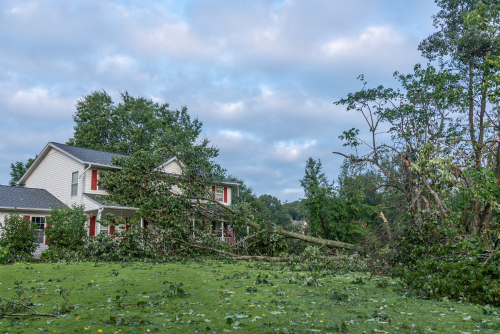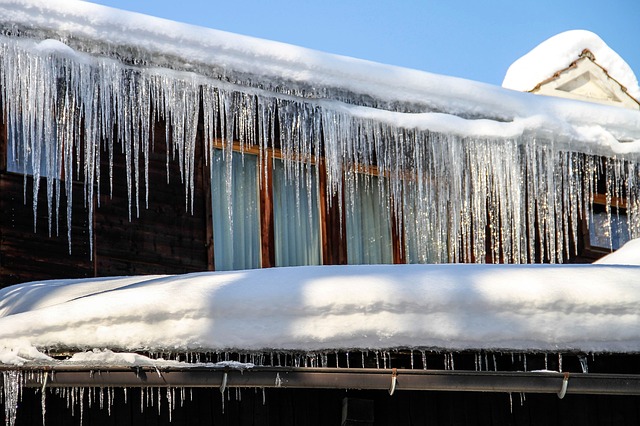In the United States, many types of storms tend to prevail, causing destruction ranging from minimal to massive. Falling precipitation has the potential to lead to serious water damage. Homeowners should be prepared by understanding what causes the most damage during various storms.
Hail Storms
Thunderstorms are capable of producing hail of all sizes:
- Smaller hail can devastate plants, cutting through their leaves. Farmers’ crops consequently take a disastrous hit.
- Larger hail pummels through rooftops and the hoods of cars; large hail can even shatter windows.
Hailstorms last about five minutes on average. Yet, hailstorms cause an estimated $1 billion in damage annually. Hail varies in size and hardness, leading to different sized dents and impressions on the roof. A rooftop damaged by hail can lead to roof leaks, and consequently, interior water damage.
Thunderstorms
Aside from hail, thunderstorms produce flash flooding, which kills more people annually than tornadoes or lightning. Dangerous and unpredictable, lightning is responsible for fires. A lightning strike to a property sends electricity through it and damages electrical appliances plugged into outlets.
Flash Flooding
Flash flooding can occur in the wake of a thunderstorm. Slowly moving thunderstorms are the primary cause of most flash floods. Intense rains can lead to flash flooding within minutes or hours and trigger mud slides. Rising water can reach 30 feet, tear out trees and destroy buildings.
Windstorms

Strong winds during thunderstorms can reach 120 mph and knock down powerlines and trees. In fact, the damage from thunderstorms is more common than destruction caused by tornadoes. Surprisingly, the ruin caused by heavy winds during thunderstorms can equal the damage caused by tornadoes.
Winds become destructive when they reach speeds of 40 to 50 mph. These gale-forced winds can snap tree branches. Even more destructive are storm-force winds, which have the power to uproot trees. The fencing around the property is also easily destroyed during heavy windstorms.
Additional destruction caused by windstorms affects the roof. Roofing materials are blown away, leaving the structure even more vulnerable to the elements. Freestanding items on the deck can become dangerous projectiles during windstorms and send the objects careening through windows.
Tornadoes
Exceeding speeds of 300 mph, tornadoes are an unavoidable threat. The damages caused by tornadoes result primarily from the high winds and the large debris, like vehicles and broken glass, which the winds propel through the area. Tornadoes can even rip homes to shreds.
Thunderstorms release an energy that sets tornadoes in motion. When climatic conditions are right, tornadoes form. Spring and summer are when tornadoes are more likely to occur.
Blizzards

The combination of heavy snows, high winds and freezing temperatures create severe winter storms known as blizzards.
What Damage Do Blizzards Cause?
Properties and vehicles often undergo significant damage caused by blizzards.
Roofs: Roofs are susceptible to collapsing under the weight of heavy snowfall, leading to hazardous conditions. Heavy snows also weigh down tree branches, which can break and fall onto nearby rooftops and cause roof damage.
Interior: A collapsed roof allows more than pests into the home. The gaping hole is a pathway for melting snow and slush. The inevitable outcome is interior water damage.
Fortunately, homeowners have some recourse to prevent damage caused by blizzards, specifically a collapsed roof. Before an anticipated blizzard, salt the roof and gutters. After snowfalls, remove the snow from the roof using a snow rake, which prevents snow accumulations from adding unbearable weight to the rooftop.
Ice Storms
During ice storms, freezing rain covers surfaces with a layer of ice. The accumulation of ice of more than a quarter inch can break tree branches and cause power outages. Serious roof damage can also result from ice storms. Split seams in the rooftop allow leaks and interior water damage.
Hurricanes
Wind gusts over 73 mph are classified as hurricane-force winds. The severity of hurricane-force winds ranges from one to five, with winds reaching 157 mph in category five hurricanes. Properties in the path of hurricanes are susceptible to being battered as well as serious water damage.
Polluted Water
When severe flooding ravages an area, the water is likely to be contaminated. Pollutants, such as sewage, chemicals and debris, turn clean water into toxic, black water. The contaminated floodwaters pose a serious threat to human and animal health and destroy the environment.
The polluted floodwaters may teem with various bacteria, pathogens and viruses. People and animals are advised to avoid coming into prolonged contact with contaminated floodwater. Rather, property owners should consult a water damage restoration service to clean and sanitize affected areas.
Water damage is likely to result from various types of storms. Hailstorms, thunderstorms, wind storms, ice storms, winter storms and tornadoes commonly lead to property damage. The resulting ruin gives water access into the interior parts of the home or commercial property.
When leaks occur, it is critical to address the situation promptly. Water damage cleanup companies in Boston, MA, such as ServiceMaster Disaster Associates, Inc, dispatch experienced crews immediately to the disaster site. Technicians work rapidly to clean up the mess and prevent the water damage from spreading.
ServiceMaster Disaster Associates, Inc, is quick to respond to water and storm damage emergencies. Once our trained technicians are onsite, we assess the extent of destruction and create a workable restoration plan. Using advanced extraction equipment, specialists draw out all excess water.
To complete the water damage cleanup process, our skilled technicians place powerful dehumidifiers in the vicinity to extract remaining traces of moisture. We’ll clean and restore personal property. Carpet and wood floor drying are also included in our comprehensive water damage cleanup services.
Contact Us 24/7 for Natural Disaster Restoration Services in Stoneham, MA
When you notice water or flood damage after a storm, consult the industry pros, ServiceMaster Disaster Associates, Inc, for our rapid response and professional approach. Countless home and business owners in Stoneham, Massachusetts, choose us for effective water damage restoration.
What Causes the Most Damage During a Storm? was last modified: October 1st, 2020 by ServiceMaster Disaster Associates, Inc.

